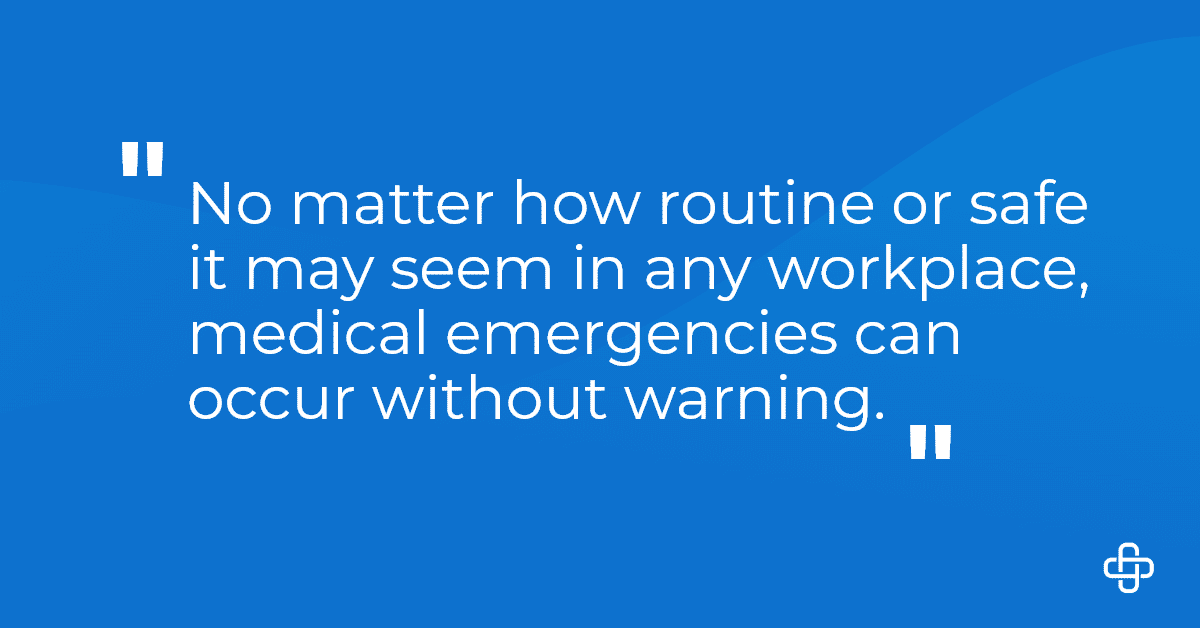When Every Second Counts: Handling Common Workplace Medical Emergencies
Imagine a typical day at work. The hum of conversation, the clatter of machines, and the endless to-do lists.
Now, imagine that day interrupted by a sudden medical emergency. Would you or your team know exactly how to respond?
Workplace safety and preparedness are not just checkboxes on a compliance list; they’re crucial elements that ensure the well-being of every individual in your organization.
Common Medical Emergencies in the Workplace
No matter how routine or safe it may seem in any workplace, medical emergencies can occur without warning.

Recognizing the types of emergencies that can arise is the first step in being prepared.
Slips, Trips, and Falls
Slips, trips, and falls are the most frequent workplace injuries. They can happen anywhere from a slick floor in an office to cluttered walkways in a warehouse. These incidents often lead to sprains, fractures, or even head injuries.
Understanding where these risks are most prevalent can help organizations take preventative measures, such as installing non-slip flooring and ensuring walkways are free from hazards.
Burns
Burns are another common workplace emergency, particularly in restaurants, laboratories, or manufacturing facilities. They can range from minor to severe and require immediate attention to prevent long-term damage.
Protocols for handling such injuries, including the location of burn kits and the process for seeking medical assistance, are crucial.
Preparing for Emergencies
Preparation is key to minimizing the impact of medical emergencies in the workplace. Creating a comprehensive emergency response plan is essential for any organization.
- Start by assessing the specific risks associated with your workplace environment. This involves identifying potential hazards and determining the likelihood of different emergencies. Once risks are assessed, develop a plan that includes clear procedures for each type of emergency.
- Training staff is a critical component of emergency preparedness. Regular training sessions should be conducted on first aid, CPR, and emergency equipment like defibrillators.
- Employees should know exactly what to do and who to call during an emergency. Consider conducting drills to simulate various scenarios, allowing employees to practice their response skills in a controlled environment.
- Another crucial aspect of preparation is ensuring that first-aid kits are readily accessible and well-stocked. Each kit should contain basic supplies such as bandages, antiseptics, and burn ointments.
- Emergency exits and routes should be marked, and employees should be familiar with them to ensure a swift evacuation if necessary.
Immediate Response
In a medical emergency, the initial response can make all the difference. Having clear, actionable steps in place is essential.
For slips and falls, quickly assess the injured person’s condition and avoid moving them if a serious injury is suspected. Provide comfort until medical personnel arrive. Applying ice and elevating the injured area can help reduce swelling and pain.
When dealing with burns, immediately cool the affected area with running water to minimize tissue damage. Remove any clothing or jewelry from the burn site, but do not attempt to remove anything stuck to the skin. Cover the burn with a clean, dry cloth and seek medical help, especially for severe burns.
In all situations, remaining calm and following established protocols can significantly improve outcomes.
Post-Emergency Procedures
Following up with appropriate post-emergency procedures after handling a medical emergency is important.
First and foremost, ensure that the affected employee receives the necessary medical attention and support. Depending on the severity of the incident, transportation to a medical facility may be required.
Documenting the incident is crucial for several reasons, including legal compliance and identifying areas for improvement. Record details such as the incident’s time and location, the injury’s nature, and the actions taken. This information will be valuable for conducting a post-incident review.
Providing emotional support to the affected employee and witnesses is also important. Consider offering counseling services or resources to address any psychological impact resulting from the emergency.
Finally, use the incident as a learning opportunity. Analyze what happened, identify gaps in the response plan, and make necessary adjustments to prevent future occurrences.
Legal and Compliance Considerations
Adhering to legal and compliance requirements is crucial for a safe workplace.
In the U.S., OSHA provides regulations to ensure safety, including emergency preparedness, maintaining first-aid kits, and employee training.
Stay updated on regulatory changes to protect employees and avoid legal issues. Collaborating with safety experts can enhance compliance and safety practices.
Additionally, regularly review your emergency response plan, audit safety equipment, and promote a culture where employees can report hazards and engage in training.
Conclusion
Being prepared for any medical emergency is not just best practice; it’s a necessity.
From slips and falls to heart attacks, knowing the common emergencies and how to handle them effectively can save lives and minimize the impact on your organization.
By preparing comprehensively, responding swiftly, and adhering to legal requirements, you can create a workplace prioritizing safety and well-being.
Take the next step in bolstering your team’s readiness by watching the free webinar replay of Axiom Medical’s, “Ready for Anything Tackling Medical Crises at Work,” webinar.
Gain invaluable insights into response techniques, enhance your team’s crisis readiness, and ensure your organization can handle any medical emergency confidently.
Together, we can ensure that your workplace is ready to rise to the challenge when every second counts.
Charli Pedersen is a published writer featured on Axiom Medical’s blog. She holds a bachelor’s degree in English, Professional and Technical Writing, and has experience creating content for businesses and non-profit organizations.










